





Published on Sep 12, 2023
In this project, I bring some tulips, cut them, and put them in glasses of glucose and water, and one with just water. I named them 50ml, which has 50ml of glucose and 200ml of water, the next labelled is 20ml, which has 20 ml of glucose, 200 ml of water, and the next is labled 10ml, which has 10ml of glucose, 200ml of water, and the last labbled is No sugar, so it has no Glucose, but just 200 ml of water. I will experiment if the tulips in the glasses with more glucose will survive for a less amount of time, or more amount of time then the ones with less glucose, and with just water, and find out if extra glucose is healthy for flowers or not.
My purpose is to find out what effect does glucose solution has on the longevity of cut flowers (glucose is a type of sugar needed by all plants and animals).
The amount of glucose (food for the flower) a flower gets helps the flowers survive for longer time. If the plant is given more sugar, it can survive longer than its normal life span.
• maple syrup( a kind of glucose)
• 4 jars
• One kind of flowers, Tulips(at least four)
• 2 measuring containers(one up to 15ml, and one up to 1 liter)
• Knife to cut the flowers.
• Four glasses were labelled as No Sugar, 10 ml, 20 ml and 50 ml.
• 200ml of water was added to “No sugar” glass and one fresh cut tulip was added to it.
• 200ml of water and 10 ml of maple syrup was added to “10 ml” glass and second fresh cut tulip was added to it.
• 200ml of water and 20 ml of maple syrup was added to “20 ml” glass and third fresh cut tulip was added to it.
• 200ml of water and 50 ml of maple syrup was added to “50 ml” glass and fourth fresh cut tulip was added to it.
• The day and time for the start of the experiment was noted.
• Everyday flowers were inspected to see if anyone of the flower’s petal is falling off, or if its petals or leaves are changing color. This meant that the flower is dead.
• It was noted how long each flower survived. This determined if the amount of added glucose helped the flower survive longer or shorter amount of time.
The experiment was started on Monday, January 20th at 6:00 p.m. The tulips were added to the labelled glasses as described in the Method Section. On 21st January around 5:00 pm, I noticed the flowers that had maple syrup added to their water started to lean forward and they felt weak. The petals of the flower with 50 ml of maple syrup started falling on 24th January. Also, the petals and leaves for the flower changed the color from green to brown. I figured out that the flower was no longer alive, because in a science book I’ve read that when plants die, they change their color, or their leaves or petals fall down.
On the evening of 25th January, the flower with 20ml of maple syrup had its petals falling, and changed color (including the leaves) from green to brown. It was no longer alive. Then on 26th January, the flower with 10 ml of maple syrup also died.
However, the flower that was added to the glass with just water in it did not change color, nor had its petals fallen. After the experiment, I had learned that additional sugar is not healthy for the plant, and that’s why the one with the most sugar died first, and the one with just water in the glass was still alive. It was still alive even after 6 days.
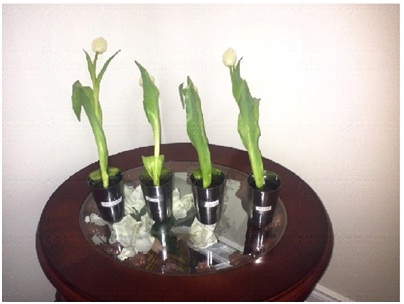
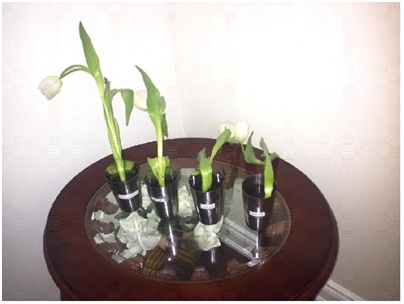
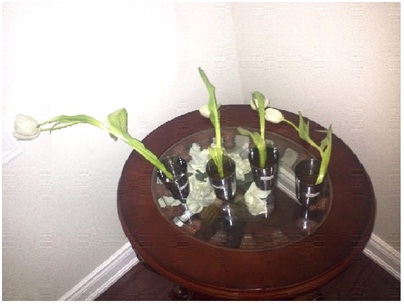
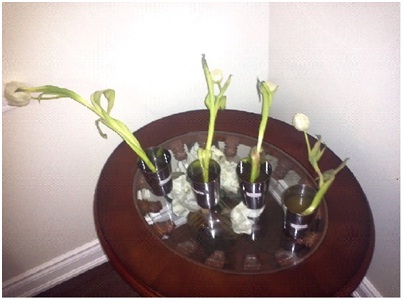
26th January, Flower with 10 ml sy
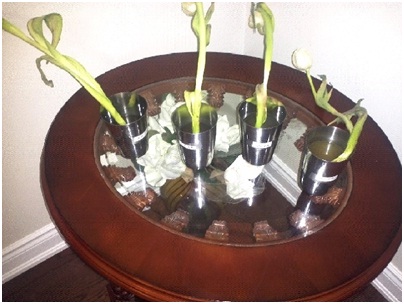
In this experiment my initial thoughts were that, if I added more glucose (maple syrup) in the three out of four glasses the flowers would live longer because sugar is healthy for the plant. However, I was wrong!!! The flowers with the maximum amount of glucose (50 ml) added to their water died first. After that the flower with 20ml of added glucose died and then the flower with 10 ml of added glucose died. The flower with water only and no added sugar survived the longest. This proves that plants do not need more sugar than the sugar they produce themselves. Adding more sugar to a plant kills it quicker than its total life span under normal conditions
1. Baily, Regina “ What is diffusion?” about.com.biology August 31, 2012. January 7 2014 http://biology.about.com/b/2012/08/31/what-is-diffusion.htm
2. Doherta, Diana “How does osmosis work?” ehow 1999-2014. January 7 2014 http://www.ehow.com/how-does4565006osmosis-work.html
3. Huntsburger, John Retired science professor personal interview January 11 2014 The importance of homeostasis GCSE bite size 2014 January 17 2014
4. http://www.bbc.co.uk/schools/gcsebitesize/sciencelabbocrpre2011homeostasis/importancev2. Narver, Mike, house builder retired biology teacher personal interview January 10 2014
5. “Osmosis and diffusion.” Quizlet.2014.January 7 http://quizlet.com/4712733/osmosisandflashcards
6. “Passive transport” Biology 4 kids.com 2013. January7 http://www.biology4kids.com/files/cellzpassivetran.htm